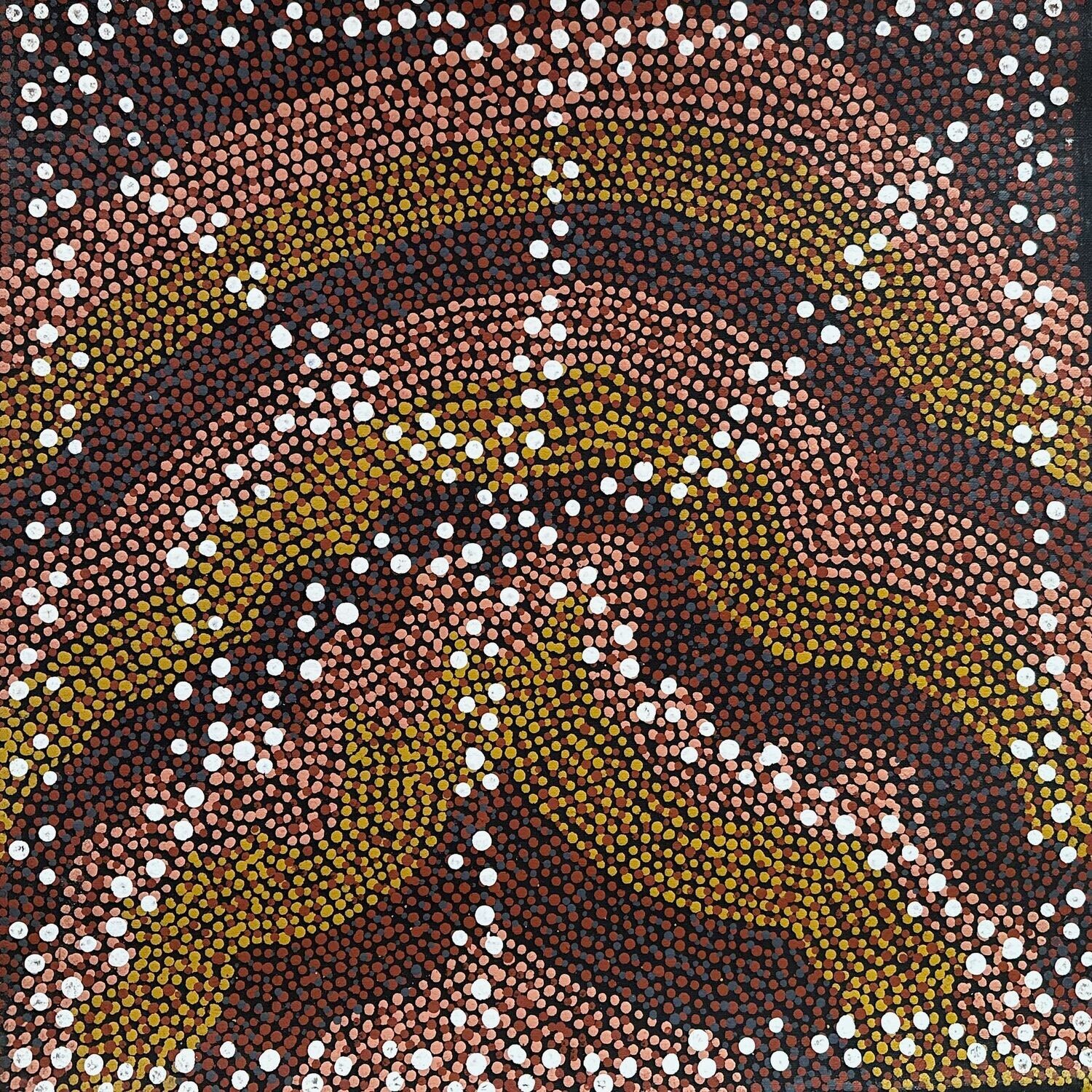Warnakiji 1999, by Polly Napangardi Watson 45x45cm
Warnakiji (Bush Tomato) 1999 – Polly Napangardi Watson
"Warnakiji (Bush Tomato) 1999" by Polly Napangardi Watson is a masterfully executed painting that highlights an important bush food of the Central Desert. The warnakiji is a native desert fruit that can be eaten raw or cooked over fire after the removal of its poisonous black seeds. It has a taste similar to an apple and holds great significance in traditional Aboriginal diet and culture.
Polly Napangardi Watson’s interpretation of Warnakiji Jukurrpa (Bush Tomato Dreaming) is deeply connected to her country, Kurnpu, near Mount Doreen, west of Yuendumu in the Tanami Desert, approximately 350 km northwest of Alice Springs. Through a striking blend of dot work and traditional iconography, her painting maps the sacred landscapes where the seeds of the warnakiji traveled during the Dreaming.
The richly layered background of multicoloured dots represents the desert environment—its trees, spinifex grasses, and undulating sand dunes. The intricate white dotting traces the ancestral journey of the warnakiji, showing its movement across the land and its deep cultural and ceremonial significance.
Cultural Significance of Warnakiji Jukurrpa
The custodians of Warnakiji Jukurrpa belong to the Napanangka/Napangardi subsection, a traditional kinship system in which knowledge is passed from patrilineal aunt to niece. This relationship ensures that sacred knowledge, rituals, and Dreaming stories are preserved across generations.
In addition to Warnakiji, Polly Napangardi Watson painted several other significant Dreamings, including:
- Ngurlu (Black Seed) Jukurrpa
- Watiki (Bush Plum) Jukurrpa
- Jungunpa (Marsupial Mouse) Jukurrpa
Polly Napangardi Watson – A Pioneer in Aboriginal Art
Polly Napangardi Watson was one of the first Warlpiri women to paint, emerging as a leading artist early in her career, which began in 1987. She was a close friend of Dorothy Napangardi, Pansy Napangardi, and Rachel Jurra Napaltjarri, all of whom lived in Alice Springs in the 1980s. Together, they attended a literacy course at the Institute of Aboriginal Development (IAD), where they were introduced to painting. Encouraged by mentors, they began working at the Centre for Aboriginal Artists, a government-supported gallery that played a key role in promoting early female artists.
Polly Napangardi Watson was known for her delicate approach to dot painting, and she was one of the first artists to experiment with overdotting, creating a unique sense of depth and movement. When the government gallery closed in 1990, she transitioned to painting for Gallery Gondwana, where she became one of their most successful and sought-after artists.
Legacy and Influence
Polly Napangardi Watson’s work remains highly regarded for its sophisticated use of colour, intricate dot work, and deep cultural narratives. Her paintings are held in major public and private collections, showcasing the artistic and spiritual traditions of the Warlpiri people.
Her contribution to the Aboriginal art movement paved the way for future generations of female artists, ensuring that Warlpiri Dreaming stories continue to be celebrated on a global scale.
GALLERY GONDWANA
ABN: 75 009 652 046
All prices displayed in AUD, GST included.
Gallery Gondwana acknowledges the First Peoples of this land and recognises their continuous connection to culture, community and Country.
CONTACT US
+61 417 75 74 75
+61 417 27 44 31
roslyn@gallerygondwana.com.au
PO Box 3770, Alice Springs NT 0871 Australia
Vatu Sanctuary
Saturate yourself and be inspired by the power of Aboriginal art in a living gallery environment.

All Rights Reserved | Gallery Gondwana
